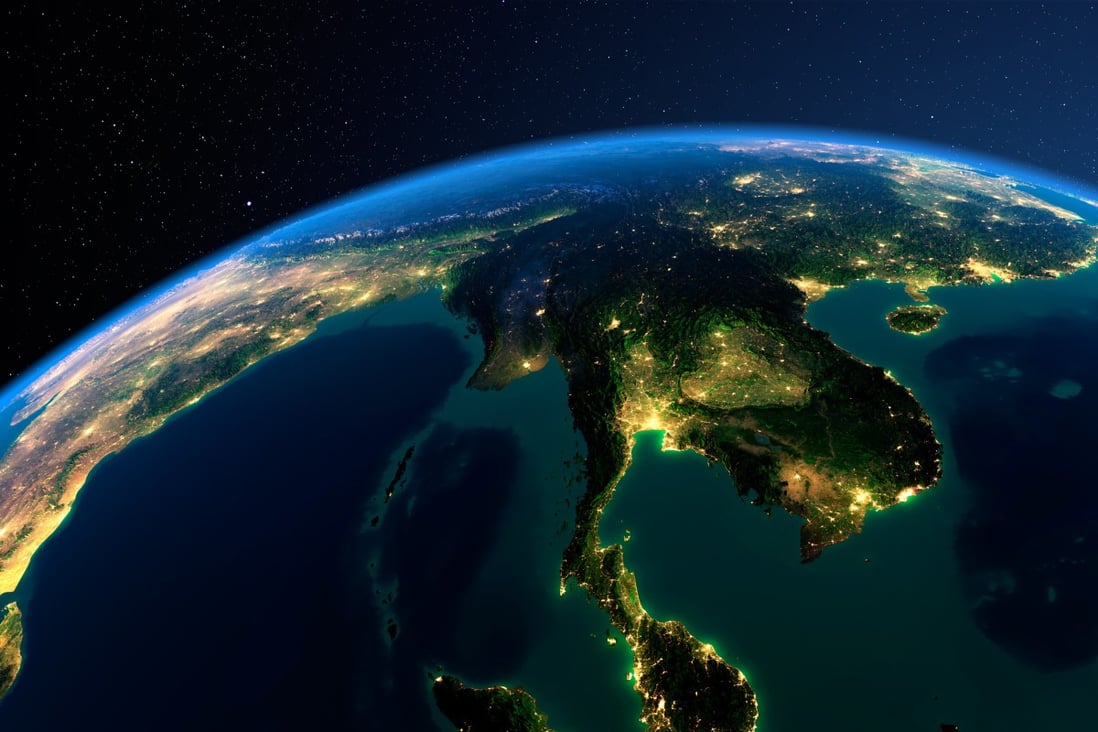Night skies illuminate Southeast Asian economic shift towards China

- A
study of artificial light clusters shows the region’s centre of
economic gravity moving northwest by an average 145 metres per day
- Chinese research team said 2012-2021 satellite data also revealed surge in brightness after financial crisis and pandemic

The
gravitational pull of the massive Chinese economy is on vivid display
under the night skies, with artificial light spots getting brighter and
closer to China, according to a new study.
The gravity centre around which most of the lights are concentrated has moved northwest towards Southeast
Asia’s land border with China by 476km (300 miles) in less than a
decade – equivalent to an average pace of nearly 145 metres (475 feet)
per day, the study said. The
research team, led by Yunnan University geology professor Li Yimin,
used satellite images from 2012 to 2021 to measure the spatial
distribution and movement trends of artificial light patterns across 11
Southeast Asian countries.
Most countries, from wealthy Singapore to less developed Cambodia, have been glowing up fast, with light intensity in the dimmest areas growing nearly 50-fold. The brightest areas are three times brighter, according to the researchers.
Most countries, from wealthy Singapore to less developed Cambodia, have been glowing up fast, with light intensity in the dimmest areas growing nearly 50-fold. The brightest areas are three times brighter, according to the researchers.
Li
said the changes provided intuitive but hard evidence of the
“remarkable efforts” made by local governments and people to stimulate
economic growth and elevate living standards in Southeast Asia.
“The northward shift of the economic gravity centre is also related to the Belt and Road Initiative,” she said, in the peer-reviewed study published in June by the Journal of Nanjing University of Information Science and Technology’s nature science edition.
“The northward shift of the economic gravity centre is also related to the Belt and Road Initiative,” she said, in the peer-reviewed study published in June by the Journal of Nanjing University of Information Science and Technology’s nature science edition.
Nearly 150 countries have signed up to the belt and road infrastructure investment plan since it was proposed by President Xi Jinping in 2013, with all Southeast Asian countries taking part.
The region also received the highest share of direct investment, with seven out of 10 of China’s top destinations for funding in recent years located in Southeast Asia, according to some estimates. Some belt and road projects – such as the 414km China-Laos railway and the 350km/h (217mph) high speed railway connecting the Indonesian capital Jakarta with the city of Bandung – aim to boost connectivity between people.
But most initiatives are focused on building up the industrial abilities of China’s neighbours.
For example, Chinese investors have poured billions of US dollars into Myanmar’s Kyaukphyu Special Economic Zone and the Malaysia-China Kuantan Industrial Park for the construction of deep seaports and factories.
Southeast Asia replaced the European Union as China’s largest trading partner last year. But the full picture of the growing bond cannot be captured by the economic data alone, according to Li and her team. They said that because it was not influenced by subjective reporting or the estimation methods used in trade or GDP data, the extent of artificial light was a more reliable and consistent indicator of economic activity.
The scientists said changes in artificial light could also capture variations in economic development at a finer scale – such as the growth of urban centres or industrial towns – which may not be evident in aggregate economic figures. The team detected two distinct leaps in the shift of Southeast Asia’s economic gravity centre towards China, indicating that progress has not always followed the same steady pace.
Satellite data shows the gravitational centre of artificial light in Southeast Asia has been moving northward towards China over the past decade, according to the study. Illustration: Yunnan University The first surge in brightness occurred between 2012 and 2013, in the aftermath of the financial crisis, while the second took place during the Covid-19 pandemic in 2020 and 2021. The findings showed that the bond between China and Southeast Asian countries tended to tighten in the wake of major crises, the researchers said.
The study also revealed a significant concentration of the lights, suggesting a fast and effective integration of the region’s different economies, they said. The Philippines was the only country to go backwards, with an increase in its relatively dim areas, according to the study. The scientists said this indicated the country had a greater challenge than others in its recovery from the pandemic.
Overall, “Southeast Asia is currently one of the most promising regions for economic development”, Li and her team said. “It holds an important strategic position and political and economic significance in the context of building a community with a shared future for mankind.” With China and the US competing for influence in the region, it was unclear from the study how the geopolitical power play between the world’s two largest economies may be affecting the distribution of artificial light in the region.
Li’s team has been contacted for comment. A study by the Lowy Institute in April found that China’s economic influence in Southeast Asia was more than double that of the US. But the US had more than double China’s military influence in the region, it said.